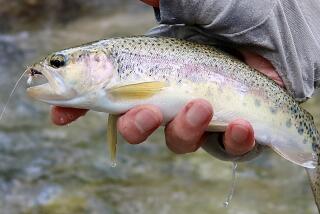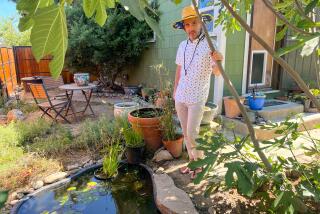Something Fishy
- Share via
Things are going swimmingly at the Fillmore Fish Hatchery, which offers an inexpensive and entertaining family excursion.
And since fish know no holidays, the hatchery is open 365 days a year. It’s just the place for an unusual pre-turkey outing.
There is no charge to visit the hatchery, which is operated by the California Department of Fish and Game. It attracts 3,000 to 7,000 visitors a month.
One recent visitor was Barbara Higgins of Ventura.
“I was here once before in 1962, but I don’t remember anything at all about it,” Higgins said. “Today I have my grandkids, so I thought I’d bring them.”
The hatchery, a mile south of Fillmore, has been raising several kinds of trout for release into state waters since it opened almost 60 years ago.
An inscription near the entrance shows the place was dedicated on July 19, 1942, when Culbert L. Olson was governor. It was used as a set in the 1949 Roy Rogers shoot-’em-up “Susanna Pass.”
*
Why trout and not piranhas or giant squid? State officials view trout as California’s primary and most widespread aquatic resource, occurring in more than 18,000 miles of the state’s streams, lakes and reservoirs. Trout fishing accounts for about two-thirds of all angling activity in the state, generating an estimated $3 billion in income and more than 92,000 jobs. The DFG, which is responsible for managing the state’s trout resources, is mandated to provide a diverse range of angling opportunities.
But the natural supply of fish falls a little short of demand. To help out, 22 hatcheries are scattered throughout the Golden State, from the Iron Gate Hatchery near the Oregon border to the southernmost Mojave River Hatchery. Fifteen sites raise trout; seven raise salmon. Four strains of trout are raised in Fillmore, said hatchery employee Ken Robledo.
“They’re all rainbow trout, but they spawn at different times of the year, so the eggs hatch at different times of the year,” Robledo said. “Therefore, we have catchable-sized fish year-round because we get the eggs at different times. The fish average half a pound when we release them, plus we have some 1-pounders, sort of trophy fish that stay here about a year and a half.”
But visitors can only see how the fish they may someday catch in the wild are raised. In fact, a sign in the parking lot lays down the law, in the form of DFG Code 1124: “No fishing for fish, crayfish or frogs.”
Despite this warning, lures confiscated from some of the laziest and dumbest anglers around are displayed in the office.
“They always have some angle--you know, try and scoop them out with cups or plastic bags or whatnot,” Robledo said. “I guess the temptation is just too great. Sometimes people try to fish just outside the fence, which is a couple of hundred dollars’ fine. You cannot fish within 250 feet of a fish ladder or a fish facility of any kind.”
Inside the fence are four 1,000-foot-long concrete waterways, one for each type of trout. Each channel is divided into 10 sections so the fish can be segregated by size, from a few inches up to almost a foot long. That’s because a big fish in a small pond is big trouble, especially for the small fish.
At the south end is a big locked metallic box to control water flow.
Full-time employees live at the facility because, should one of the pumps fail, the fish would be killed by a lack of oxygen. There are backup diesel generators for such an eventuality.
*
The entire hatchery facility is enclosed by a wire screen to keep birds out, although a few happy blackbirds hang out inside. On the north end, about 30 egrets and herons wait patiently in trees surrounding a pond just outside the fence, possibly reminiscing about the good old days when birds ate about 30% of the hatchery’s fish. There are several types of egrets, three types of herons and all sorts of smaller birds, as well as weasels and muskrats. Meanwhile, a couple of adult trout escapees cruise slowly around the pond, a good foot-and-a-half long and way too big for even a starving egret to swallow.
They’re the lucky ones. Inside, the pens are as crowded as the 405 at rush hour. The trout appear as animated dark gray shadows. Some of the larger specimens have a metallic pink hue on their lower half when the light hits them just right, hence the “rainbow” name.
The fish consume about 2,000 pounds of food a day, mostly animal protein. It costs the state $2 to grow a pound of trout.
The product ends up in 40 streams, reservoirs and lakes in Ventura, Santa Barbara, San Luis Obispo and Los Angeles counties.
Because there’s not a lot for them to do at the hatchery besides eat, the fish seem to have an appetite the size of Wyoming. For a quarter a serving available from handy dispensers, visitors can toss feed pellets to the fish and watch the action.
The trout react to movement, which often means chow time.
“We have quite a few visitors here, especially on weekends, so [the fish] know that movement can either be a person or the actual feed cart--we have electrical carts--so when they feel the vibration or see the movement, they know they’re about to be fed,” Robledo said. “They become conditioned because they’re fed pretty much at the same time every day.”
*
Do the fish have a future? Not much. Most last about a week after they’re released, according to Robledo, although some make it longer.
“That’s the reason we plant them--put and take,” Robledo said. “But there are certain streams where they will become evasive and turn wild and not be caught and adapt to the wild, where they become holdover fish. They can live to maybe five years in the wild, but sometimes they commit suicide and jump out of the pond.”
But let’s go for the big question. How does the trout taste?
“You know, I don’t eat too much trout,” said Robledo. “I’m around them all the time.”
DETAILS
Fillmore Fish Hatchery, Fish Hatchery Road, one mile south of Fillmore off Highway 126, open daily 8 a.m. to 3 p.m.; free; 524-0962.
*
Bill Locey can be reached by e-mail at [email protected]
More to Read
Sign up for The Wild
We’ll help you find the best places to hike, bike and run, as well as the perfect silent spots for meditation and yoga.
You may occasionally receive promotional content from the Los Angeles Times.






